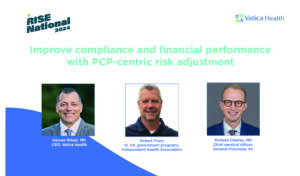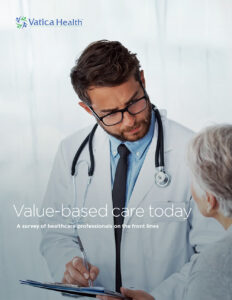We’ve said it before: primary care providers are facing the perfect storm sparked by COVID-19. There are fewer routine and preventive visits, revenue is down, and offices are short-staffed. Fortunately, there is a path forward.
Telehealth has skyrocketed and is becoming the most practical way of providing primary care during these uncertain times. However, despite the surge in telehealth popularity, PCPs are having trouble taking full advantage of the benefits that telehealth offers to boost their practices – especially among seniors.
In a recent on-demand webinar, Dr. Hassan Rifaat (Vatica Health’s CEO) and Daphney Vick (Vatica Health’s EVP, Operations) were joined by two primary care physicians that use Vatica Health’s solution. They shared their insights on how providers can leverage telehealth (especially real-time audio+video) to generate revenue, help patients stay on track with routine and preventive care, and keep their practices productive and financially viable. Below are a few highlights from the webinar.
Telehealth is here to stay
Providers have been quick to adapt to telehealth and, thanks to recent rulings, many PCPs plan to keep telehealth as an option post-pandemic after seeing the value that it can provide for routine care and reimbursable visits. Many health plans are also moving toward the permanent expansion of telehealth services.
But there is an important distinction between providing care using audio only – and more comprehensive telehealth as defined by CMS which requires real-time audio and video. While telephone-only may be satisfactory in certain circumstances, the key to maximizing telehealth is to ensure that it can also be used for risk adjustment, value-based care and other performance optimizing programs. For HCC coding in support of risk adjustment, CMS guidance states that PCPs’ telehealth options must be real-time audio-visual, and not just telephonic.
Real-time audio+video telehealth is not just better for the practice, it’s also better for patients. Imagine watching a movie versus just listening to it—there’s much more information to absorb, and it’s also more engaging. Patients agree: 62% of patients at MGH reported in a survey that the quality of care via video visits was the same as in-person visits.
Patients are already set up for success
While patient adoption of telehealth has been a hurdle for PCPs, some data shows that it’s catching on. Fifty-two percent of senior patients are willing to try telehealth, and many of them already have. Additionally, when asked about switching PCPs based on telehealth offerings, or lack thereof, the vast majority of seniors would rather stay with their own PCP. This is good news because there is a proliferation of telehealth service providers that are aggressively targeting your patients, making telehealth an important initiative to retain your patients.
In our webinar, family physician, Monica Ranaletta, DO, shared that the learning curve for video telehealth has been quick and easy. Once her patients have one video telehealth visit, even with another provider, the process becomes intuitive.
Also, on the webinar, Shanthi Rajendran, MD, and her colleague Sarah Boyer, PA, shared that they have been surprised at how equipped their senior patients have been for telehealth. Keeping up with the times and with their younger family members, many seniors already had the basic video tools in place to do audio-visual telehealth.
Taking the next steps with audio-video telehealth
Though patient adoption of telehealth is growing, it doesn’t just happen overnight and can take some time for providers to get the ball rolling and the process optimized.
On the webinar, the Vatica Health team, joined by Dr. Rajendran, Boyer, and Dr. Ranaletta, shared some key steps that providers can take to improve the use of telehealth for their patients and their practices, including:
- Member engagement to drive participation and utilization
- Educating patients about your practice’s telehealth options and use cases
- Administrative functions to make telehealth an easy option for patients
- Pre-visit tasks that help ensure patients are ready for appointments and show up for them
- User experience and platform tips that help make telehealth clear and enjoyable
- In-visit best practices for keeping patients engaged and improving their overall experience
Boyer shared that though this may seem like a lot to think about, she and Dr. Rajendran have found a rhythm and have successfully integrated telehealth into their operations. The experience is similar for Dr. Ranaletta, who estimates that 80% of her appointments are now via telehealth.
To hear more from our team and Vatica Health’s PCPs using telehealth to improve their practice performance and patient experience, watch the on-demand webinar.












